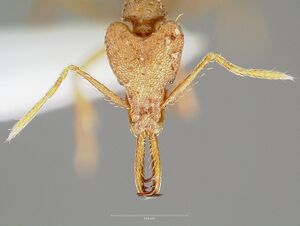Strumigenys hilaris
| Strumigenys hilaris | |
|---|---|

| |
| Scientific classification | |
| Kingdom: | Animalia |
| Phylum: | Arthropoda |
| Class: | Insecta |
| Order: | Hymenoptera |
| Family: | Formicidae |
| Subfamily: | Myrmicinae |
| Tribe: | Attini |
| Genus: | Strumigenys |
| Species: | S. hilaris |
| Binomial name | |
| Strumigenys hilaris Fisher, 2000 | |
Known from rainforests, specimens have been collected from litter, a rotten log, and under a rock.
Identification
Bolton (2000) - A member of the hilaris complex in the Strumigenys arnoldi-group. S. hilaris, Strumigenys luca and Strumigenys milae constitute the hilaris-complex, characterized by 2 preapical teeth or denticles on the left mandible and the absence of a projecting pronotal humeral hair. Within this complex, hilaris can be identified by its relatively long scape, SI > 90.
Keys including this Species
Distribution
Latitudinal Distribution Pattern
Latitudinal Range: -14.44528° to -14.44528°.
| North Temperate |
North Subtropical |
Tropical | South Subtropical |
South Temperate |
- Source: AntMaps
Distribution based on Regional Taxon Lists
Malagasy Region: Madagascar (type locality).
Distribution based on AntMaps
Distribution based on AntWeb specimens
Check data from AntWeb
Countries Occupied
| Number of countries occupied by this species based on AntWiki Regional Taxon Lists. In general, fewer countries occupied indicates a narrower range, while more countries indicates a more widespread species. |

|
Estimated Abundance
| Relative abundance based on number of AntMaps records per species (this species within the purple bar). Fewer records (to the left) indicates a less abundant/encountered species while more records (to the right) indicates more abundant/encountered species. |

|
Biology
|
Castes
Worker
Images from AntWeb
   
| |
| Paratype of Strumigenys hilaris. Worker. Specimen code casent0005553. Photographer April Nobile, uploaded by California Academy of Sciences. | Owned by MCZ, Cambridge, MA, USA. |
Queen
Images from AntWeb
   
| |
| Paratype of Strumigenys hilaris. Queen (alate/dealate). Specimen code casent0005554. Photographer April Nobile, uploaded by California Academy of Sciences. | Owned by MCZ, Cambridge, MA, USA. |
   
| |
| Paratype of Strumigenys hilaris. Queen (alate/dealate). Specimen code casent0005555. Photographer April Nobile, uploaded by California Academy of Sciences. | Owned by MCZ, Cambridge, MA, USA. |
Nomenclature
The following information is derived from Barry Bolton's Online Catalogue of the Ants of the World.
- hilaris. Strumigenys hilaris Fisher, in Bolton, 2000: 661, fig. 396 (w.q.) MADAGASCAR.
Unless otherwise noted the text for the remainder of this section is reported from the publication that includes the original description.
Description
Worker
Holotype. TL 3.1, HL 0.75, HW 0.55, CI 74, ML 0.43, MI 57, SL 0.53, SI 96, PW 0.34, AL 0.77. Characters of hilaris-complex. Mandibles inserted close together and slightly diverging at full closure. Each mandible with 2 preapical teeth, situated in the apical third of the length; proximal preapical tooth longer than distal. Upper scrobe margin bordered by a narrow rim throughout its length. Eye small, convex, and plainly visible in full-face view; its maximum diameter more or less equal to maximum width of scape. Scape more or less straight, widest in the midsection; hairs on leading edge fine, slightly flattened or spoon-shaped apically. Cephalic dorsum densely clothed with curved to subappressed narrowly spatulate ground-pilosity; upper scrobe margin fringed with curved narrowly spatulate hairs. Cephalic dorsum with 4 simple standing hairs arranged in a transverse row close to the occipital margin and a more anteriorly situated pair on vertex. Pronotal humeral hair absent; humeral angles rounded. Anterior margin of mesonotum with a pair of stout filiform hairs. Propodeum with two pairs or occasionally one pair of short, fine, posteriorly curved hairs immediately anterior of propodeal spines or at base of propodeal spines. Ground-pilosity on alitrunk as on head but sparser. Dorsum of alitrunk in outline convex anteriorly, more or less flat posteriorly. Anterior mesonotum without a distinct carina above the mesothoracic spiracle. Propodeal spines narrowly triangular, strongly elevated; propodeal lamella absent. Alitrunk dorsum and sides of pronotum densely reticulate-punctate, pleurae smooth and shiny with peripheral punctures. Fine longitudinally striolate sculpture present on pronotal dorsum; rugulose sculpture present on posterior lateral margins of pronotum. Petiole node in dorsal view about as broad as long. Postpetiole disc densely and finely reticulate-punctulate with longitudinally striolate sculpture. In profile ventral spongiform tissue of petiolar peduncle a very narrow, irregular strip that is deepest in posterior third of petiole, the deepest point of the tissue less than maximum width of eye. Ventral spongiform lobe of postpetiole moderately developed. Basigastral costulae short and distinct. Petiole with a pair of stiff standing hairs. Dorsal surfaces postpetiole and gaster with stout standing hairs. Colour light yellowish brown to medium brown.
Paratypes. TL 3.0-3.1, HL 0.72-0.75, HW 0.52-0.55, CI 71-74, ML 0.42-0.43, MI 55-59, SL 0.50-0.54, SI 94-100, PW 0.32-0.34, AL 0.74-0.79 (6 measured). As holotype.
Type Material
Holotype worker, Madagascar: Marojejy R. N. I #12, 14°26'43.2"S, 49°47'8.3"E, 375 m., 18.xi.1993, rainforest, winkler app. #44.11127 (G. D. Alpert) (Museum of Comparative Zoology).
Paratypes. 5 workers and 1 queen (dealate) with same data as holotype but dated 20.xi.1993 and coded 108.13991, 108.13987, 108.13990, 108.13988; 1 worker and 1 queen (dealate) with same data as holotype but 665 m., 20.xi.1993 (Alpert et. al.), #106.10822, and #106.10820 (The Natural History Museum, South African Museum).
References
- Fisher, B.L. 2000. The Malagasy fauna of Strumigenys. Pp. 612-696 in: Bolton, B. 2000. The ant tribe Dacetini. Memoirs of the American Entomological Institute. 65:1-1028. (page 662, worker described)
References based on Global Ant Biodiversity Informatics
- Bolton, B. 2000. The Ant Tribe Dacetini. Memoirs of the American Entomological Institute 65
- Fisher B. L. 2003. Formicidae, ants. Pp. 811-819 in: Goodman, S. M.; Benstead, J. P. (eds.) 2003. The natural history of Madagascar. Chicago: University of Chicago Press, xxi + 1709 pp.

